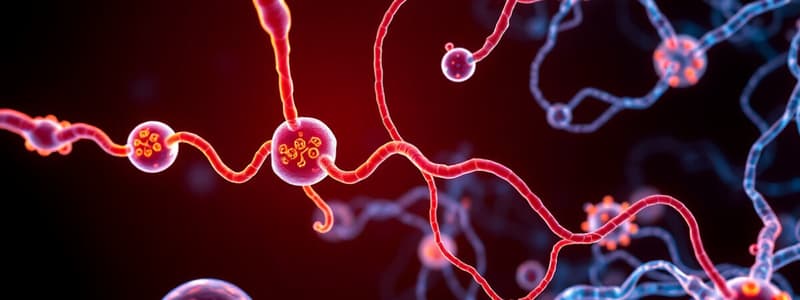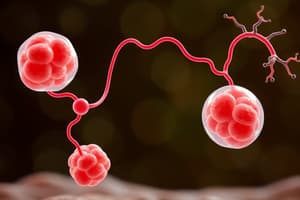Podcast
Questions and Answers
What is the primary product of glycolysis?
What is the primary product of glycolysis?
- Acetyl CoA
- Fructose 1,6-bisphosphate
- Glucose 6-phosphate
- Pyruvate (correct)
What is the net production of ATP through glycolysis?
What is the net production of ATP through glycolysis?
- 2 ATP (correct)
- 4 ATP
- 6 ATP
- 1 ATP
Which molecule is involved in the oxidation step of glycolysis?
Which molecule is involved in the oxidation step of glycolysis?
- ATP
- NAD+ (correct)
- ADP
- FAD
In what condition is pyruvic acid converted to lactic acid?
In what condition is pyruvic acid converted to lactic acid?
What happens to fructose 1,6-bisphosphate during glycolysis?
What happens to fructose 1,6-bisphosphate during glycolysis?
How many molecules of NADH are produced in glycolysis?
How many molecules of NADH are produced in glycolysis?
Which reaction requires ATP in the initial stages of glycolysis?
Which reaction requires ATP in the initial stages of glycolysis?
What does the term 'anaerobic cellular respiration' refer to in the context of glycolysis?
What does the term 'anaerobic cellular respiration' refer to in the context of glycolysis?
Flashcards
What is glycolysis?
What is glycolysis?
The breakdown of glucose into two 3-carbon molecules of pyruvate. This process occurs in the cytosol and does not require oxygen.
What are the net products of glycolysis?
What are the net products of glycolysis?
Glycolysis produces 4 ATP molecules, 2 NADH molecules, and 2 pyruvate molecules.
Explain the 10 chemical reactions in glycolysis.
Explain the 10 chemical reactions in glycolysis.
- Glucose is phosphorylated to form glucose 6-phosphate. 2. Glucose 6-phosphate is converted to fructose 6-phosphate. 3. Fructose 6-phosphate is phosphorylated to form fructose 1,6-bisphosphate. 4. Fructose 1,6-bisphosphate splits into glyceraldehyde 3-phosphate and dihydroxyacetone phosphate.
- Dihydroxyacetone phosphate is converted into glyceraldehyde 3-phosphate.
- Glyceraldehyde 3-phosphate is oxidized and phosphorylated, producing NADH and 1,3-bisphosphoglycerate. 7. 1,3-bisphosphoglycerate is converted to 3-phosphoglycerate, producing ATP. 8. 3-phosphoglycerate is converted to 2-phosphoglycerate. 9. 2-phosphoglycerate is converted to phosphoenolpyruvate. 10. Phosphoenolpyruvate is converted to pyruvate, producing ATP.
What is the fate of pyruvic acid?
What is the fate of pyruvic acid?
Signup and view all the flashcards
What is NAD+
What is NAD+
Signup and view all the flashcards
What is glucose?
What is glucose?
Signup and view all the flashcards
What is pyruvate?
What is pyruvate?
Signup and view all the flashcards
Study Notes
Glycolysis Overview
- Glycolysis is the breakdown of glucose into two 3-carbon molecules of pyruvate
- This process takes place in the cytosol
- It is an anaerobic process that does not require oxygen to produce ATP
- Glycolysis produces 4 ATP and 2 NADH
10 Reactions of Glycolysis
- Phase 1 (Energy Investment):
- Glucose is phosphorylated using an ATP molecule, producing glucose-6-phosphate
- Glucose-6-phosphate is converted to fructose-6-phosphate
- Fructose-6-phosphate is phosphorylated using an ATP molecule, forming fructose-1,6-bisphosphate
- Fructose-1,6-bisphosphate is split into two 3-carbon molecules: glyceraldehyde-3-phosphate (G3P) and dihydroxyacetone phosphate (DHAP)
- Phase 2 (Energy Payoff):
- G3P is oxidized and phosphorylated, forming 1,3-bisphosphoglycerate and NADH.
- 1,3-bisphosphoglycerate is dephosphorylated, forming 3-phosphoglycerate and ATP.
- 3-phosphoglycerate is isomerized to 2-phosphoglycerate.
- 2-phosphoglycerate is dehydrated, forming phosphoenolpyruvate (PEP).
- PEP is dephosphorylated, forming pyruvate and ATP.
Fate of Pyruvic Acid
- Aerobic conditions: Pyruvic acid is converted to acetyl CoA, which enters the Krebs cycle.
- Anaerobic conditions: Pyruvic acid is reduced to lactic acid.
- Lactic acid can build up in the muscles during intense exercise and is later converted back to pyruvic acid in the liver.
NAD+
- NAD+ is a carrier molecule that traps electrons and protons (H+).
- It transfers electrons and protons to where they are needed.
- NAD+ is a low energy molecule, while NADH is a high energy molecule.
Studying That Suits You
Use AI to generate personalized quizzes and flashcards to suit your learning preferences.




